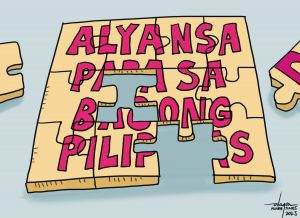How cruel can they get!
We mean the members of the Davao City Council working on a proposed ordinance adding more lashes to the flagellation that water consumers in the city are long suffering as part of their economic crucifixion.
Yes, at the behest of First district councilor Pilar Braga who is taking cue from, some environmentalist groups, a proposed ordinance termed as Payment for Ecological Services (PES) was considered approved on first reading during the regular Council session last June 4, 2024.
The proposed measure seeks to collect 25 centavos per cubic meter of water consumed by households and 50 centavos for every cubic meter of water consumed by business establishments. And we have sensed that not a single consumer can dodge the levy that will be imposed by the city government when the ordinance is approved and will take effect.
Just imagine that the collection of the PES is being negotiated to be done through the Davao City Water District (DCWD). So how can anyone connected to the water service provider escape payment when even a delay of a few days, or the most a month, the connection is cut off?
And yes we agree with the proponent that the PES will be a sustainable source of funds. For as long as the household or business establishment is connected to DCWD the collection will continue on a monthly basis forever.
How much will the city be able to generate from this, in the language of Councilor Braga, “innovative” approach in recognizing the invaluable service provided the people of Davao City by the ecosystem? Just assume that today there are already 350 thousand water consumers and say, 320 thousand of these are residential. Then assume that at the average each household consumes 10 cubic meters a month, then multiply it by 320 thousand residential consumers, times twelve months.
And if the business consumers are, again, assumed to be 30 thousand that will consume an average monthly of say, 50 cubic meters of water a month, multiplied by 12 months, how much money will the city generate? Add the collection from the residential, then it will amount to millions of pesos. Certainly it is sustainable because no one among subscribers to the water service will ever wish to have their connection cut off.
Nevertheless, we would not argue against the intentions of the proposed ordinance as these are noble. Yes, with the objective of raising funds for the conservation, restoration and management initiatives within the watershed areas the proposed ordinance is indeed “innovative.”
What is sad however, is that even ordinary consumers, in the guise of calling them as among the stakeholders, are being made to pay for the cost of the so-called “ecological services.” Maybe it is worth reminding our councilors, the sponsor and her “influencers” most specifically, that household consumers are not earning out of the water they consume. As the term household itself suggests, the water is for domestic use. So making them pay more to the already exorbitant rate currently imposed by the water provider, is adding more nails on the hands and feet of the already long-crucified residential water consumers.
Maybe the Council, when it further deliberates on the proposed local legislation, should take a much discerning look at those consumers who are making water or air and the environment as among the major articles of commerce for their businesses. After all, the cost of water that they consume is always passed on to the consumers of their products or services.
Besides, why should the Council add more burden to the household water consumers when the city is already collecting so much money in terms of taxes and other fees from business establishments, real properties and other sources as can be gleaned from the monthly income and expenditure report released by the Office of the City Treasurer? We have been working with local newspapers that publish the said report and we know that the income of the city far exceeds its monthly and annual expenses – obligatory or not. And mind you, the excess is in hundreds of millions, even billions of pesos.
So why not the City Council think of concentrating the collection of PES from establishments harnessing water for their businesses and exempt the households? And if the programs and projects related to the conservation, restoration and management initiatives of the ecosystem cost more than what can be generated from the business consumers the city may augment the funds using the accumulated savings from the city’s annual budget?
In fact it is our take that by letting the household water consumers pay the PES they are likely put into “double jeopardy”. They pay the PES for their consumption and they will also be made to pay the same when the PES paid by the business consumers are passed on to the public by increasing the cost of products and services of the business water users.


